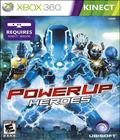Before the Kinect premiered, the idea of a motion-based fighting game sounded pretty cool. Then Fighters Uncaged hit store shelves last fall, and motion-based fighting wasn't so cool. Though it looked decent, the controls suffered from noticeable input lag. More recently, THQ took a stab at a kid-friendly Kinect fighting game with Kung-Fu Panda 2, and the result was basic, but much more responsive. Then there is the Ubisoft-published Child of Eden, which arguably sports the most responsive Kinect controls to date. Suddenly, it looks like a proper Kinect-based fighting game may not be that far-fetched. Ubisoft wants PowerUp Heroes to be that fighting game.
Inspired by comic book battles, PowerUp Heroes takes your Xbox 360 avatar and places him (or her) front and center in the game. The villains are taking over, the fate of the world is in your hands, and all you have is a basic super suit. In order to save the day, you'll need to defeat the villains one by one. Every time you defeat a villain, you earn his suit, thus adding to your arsenal. Essentially, the suits are the rough equivalent of characters in a traditional fighting game.
Before each battle, you have the ability to choose two suits to wear. Each suit sports three powers, and you can swap between them on the fly. Powers can be both offensive and defensive in nature, so it's difficult to make the wrong choice. Early on in the game, all of the suits seem to be similarly effective, but we can certainly see Ubisoft making suit selection more strategic in the latter half of the game. For example, it wouldn't be crazy to expect that certain suits would have an advantage (or disadvantage) when fighting specific opponents.
In addition to the suits, you will also earn individual power-ups as you progress through the game. These are doled out on a level-by-level basis. You earn experience points as you defeat opponents. Earn enough experience, and you move up a level. Power-ups can be selected before a match, just like the suits.
Visually, PowerUp Heroes is already looking good, with a bright and colorful style. Characters tend toward the Japanese super-deformed, big head look, which allows for the avatar-styled characters to be more expressive. Character movements are sweeping and exaggerated, and that makes it easy to see which move the individual characters are trying to perform.
Looking cool is all well and good, but in the end, it comes down to performance. In order to get a proper feel for the game, we sat down (or more appropriately stood up) with an early beta and spent a few hours busting heads. Aside from being incredibly sore (expect PowerUp Heroes to be quite the workout), we came away notably optimistic.
The fighting system in PowerUp Heroes works because it isn't completely freeform. Instead, every move has a specific pose that the Kinect uses to recognize what you want to do. Punches and kicks are basic (throw out your arm or raise your knee), while super moves have a bit more flair. For example, to throw an energy blast at your opponent, you hold your hands together and then push them outward. The most difficult part was fighting the urge to yell out, "Hadouken!" every time that happened.
While some of these movements are going to seem natural, PowerUp Heroes doesn't try to punish players by making you memorize them. Instead, all of the super move poses are displayed in a handy key in the corner of the screen. Want to toss up a shield and forget what to do? A quick glance answers the question.
PowerUp Heroes may have a focus on super moves, but it doesn't completely forgo hand-to-hand sparring. Here, things seem to take on a little more of a Quick Time Event (QTE) feel, as the game automatically decides when you've taken enough swings and directs you to use a combo-ending maneuver. When you're on the receiving end of the attack, the QTE gameplay is even more pronounced, with the game displaying exactly which poses you need to perform in order to successfully block.
Because of the way in which PowerUp Heroes handles the fighting, it is very easy to jump in and get started, and the game seems to be designed with a minimal barrier to entry. The real moment of truth isn't when you first start playing, though; it's after you've been playing for a few hours and the moves are starting to come naturally. At that point, it's possible to start throwing out commands faster than the game can manage. This isn't a knock on the game design, but an illustration of how easy the core mechanics are to learn.
After mastering the basics against the AI in campaign mode, PowerUp Heroes also promises to give you the chance to face off against human opponents both locally and over Xbox Live. There is even a four-player tournament option.
Ultimately, the biggest hurdle for the development team over the next few months is going to be eliminating as much of the input lag as possible. If PowerUp Heroes can get anywhere close to the level of precision Child of Eden offers, there is no doubt that it will be remembered as the first successful motion-controlled fighting game. Here's hoping they can pull it off.
More articles about PowerUp Heroes










 PowerUp Heroes is a full-body combat game that lets players transform their avatar into a custom superhero to face off in a fight against the forces of evil.
PowerUp Heroes is a full-body combat game that lets players transform their avatar into a custom superhero to face off in a fight against the forces of evil.












